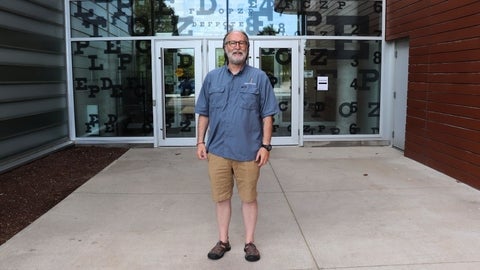
By Karen Kawawada
Dr. Trefford Simpson’s career in optometry didn’t get off to the most promising start. As a teenager in Johannesburg, South Africa, his primary interest was playing soccer. He applied to optometry school, among other programs, just because it seemed interesting. And, initially, he didn’t get in.
Then, as he was trying to decide on next steps, Simpson got a telegram saying a vacancy had arisen in the optometry program at the Witwatersrand College for Advanced Technical Education.
It was the beginning of a long and productive career in which Simpson would eventually be cited more than 10,000 times, ranked among the top two per cent of most-cited scientists and named a Fellow of the Association for Research in Vision and Ophthalmology (ARVO).
A professor at the University of Waterloo School of Optometry and Vision Science for more than 30 years, Simpson is winding down his full-time career at the end of August. He leaves a varied legacy of scholarship as well as a reputation for superb teaching and mentorship.
As a young man, though, Simpson didn’t love optometry school. In fact, he briefly considered leaving. After graduation, he completed his compulsory military service, partly as an “okay” military optometrist. Then, to forestall going into private practice, he went to the University of Houston in Texas for a master’s degree.
“The University of Houston changed my life,” says Simpson. “The notion that I could actually have a career as a vision scientist was astounding.”

Dr. Trefford Simpson in his lab
To fulfil the conditions of his student loan, Simpson returned to South Africa after his master’s. However, it was a tumultuous time. Pressure was building internally and externally to do away with apartheid, but the government was digging in its heels. As opponents of apartheid, Simpson and his wife decided they couldn’t stay, so they returned to Houston for Simpson to do a PhD.
Following his PhD, Simpson and his young family – by this time, he had twin sons – went to the University of Toronto for a postdoctoral fellowship. Then, in 1994, he came to the University of Waterloo, initially as a research assistant professor.
One discovery Simpson made outside the lab: he was born the same day as the University of Waterloo, on July 3, 1957. It must have been meant to be.
Over the years, Simpson has followed his interests into varied fields of vision science. As a PhD student, he initially researched the aging of the human retina. However, for various reasons, that project didn’t work out, so he had to pivot. His new topic became how humans judge direction.
“The way you judge direction from one eye isn’t the same as the way you judge direction from the other eye, so the brain deals with that by putting the ego’s centre right between your two eyes,” explains Simpson. “That’s not a new insight. A seminal paper was published in 1792 and I did my thesis defence in 1992. What I did was work on empirically demonstrating these rules and how the eyes work together to coordinate vision.”
During his postdoc, Simpson worked primarily on visual neuroscience – specifically, the effects of multiple sclerosis on the visual system.
When he came to Waterloo, Simpson initially researched how binocular vision – how the two eyes work together – affects contact lens wear. It was in one sense a homecoming – when he was an undergraduate optometry student, Dr. Desmond Fonn taught the class about contact lenses. Fonn later founded the Centre for Contact Lens Research, now the Centre for Ocular Research and Education (CORE), at the University of Waterloo.

Dr. Trefford Simpson, centre, with well-wishers at his retirement celebration
As time went on, Simpson began to focus more on the area he’s arguably best known for: the way we experience and process stimuli – particularly pain – on the ocular surface.
“When I started, this work wasn’t being done in humans,” says Simpson. “We still know very little about these very complicated, exquisitely sensitive processes in people. That’s what’s kept me doing it for 30 years. The interesting stuff isn’t where the light is; it’s where the shadows are.”
Throughout his career, Simpson continued to maintain diverse lines of research, for which he was almost continuously funded by bodies such as the Natural Sciences and Engineering Research Council of Canada and the U.S. National Eye Institute. In much of his work, he collaborated with students, postdocs and faculty from different backgrounds.
His curiosity, as active as ever, is why Simpson isn’t stepping away entirely when he officially retires. Despite plans to spend more time travelling, birding and taking photos, he’ll continue working on research projects and may do some teaching and consulting. He might even start a company, an idea he’s currently exploring.
“I’ve always been serious about pursuing the things I was curious about,” says Simpson. “I’ve loved what I’ve done. I love teaching, I love being a scientist, and in particular, I’ve loved working with professional and graduate school students. I’ve been very lucky to do everything I’ve done.”